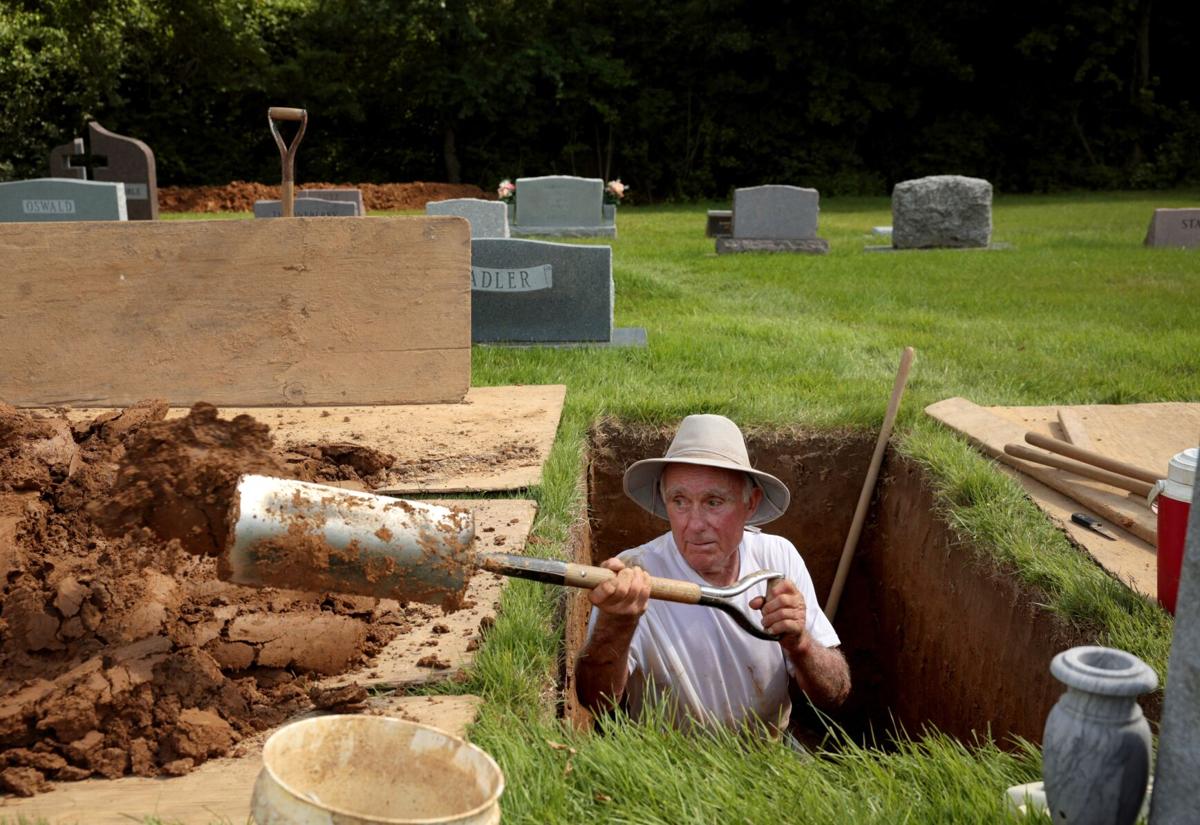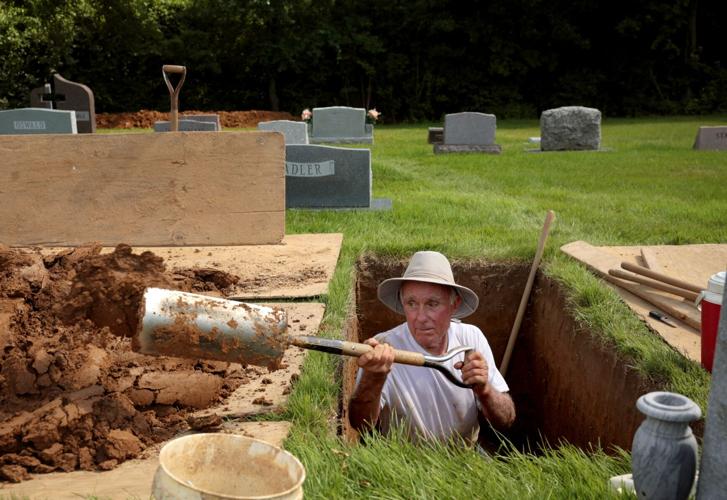ST. CHARLES COUNTY ŌĆö Paul Kamphoefner stood alone among the rows of marble and granite headstones.
The 76-year-old cattle farmer came to Zion Lutheran Cemetery in St. Charles that day to complete one task: Dig a grave for the 102-year-old woman to be buried there.
Kamphoefner is a bit of a relic. He and his sons are among the last people in the 51║┌┴Ž region who dig graves by hand.
The legion of gravediggers who once helped to lay millions of 51║┌┴Ž area residents to rest have been replaced by modern technology and heavy equipment. A backhoe or mini excavator can dig the graves faster and are considered more cost-effective.
But a hand-dug grave is different. Cemeteries hire Kamphoefner for a multitude of reasons. But mostly, they say, itŌĆÖs the tidiness of his work. He reaches spots heavy equipment canŌĆÖt and he doesnŌĆÖt leave tire tracks. The perfectly squared walls of the holes he digs keep headstones from tipping or falling over as the ground settles.
People are also reading…
ŌĆ£The old method takes a lot longer and a lot more effort, but over time, it helps us maintain a healthier looking graveyard,ŌĆØ said Mike Fieberkorn, Zion LutheranŌĆÖs associate pastor.
ŌĆ£Paul is kind of a legend around here,ŌĆØ Fieberkorn said. ŌĆ£We all kind of stand in awe of him ŌĆö we are all in our 30s and 40s and we wouldnŌĆÖt be able to do what he is doing.ŌĆØ
Most area cemeteries, including Jefferson Barracks National Cemetery, stopped having graves dug by hand decades ago.
ŌĆ£Digging a grave by hand just isnŌĆÖt done anymore,ŌĆØ said Sonny Peppers, assistant director at Jefferson Barracks National Cemetery. The cemetery used to employ a group of men who would dig graves for deceased soldiers and their spouses. It would take the men an estimated 8 hours to dig each grave, he said.
The majority of graves at Bellefontaine Cemetery and Arboretum in 51║┌┴Ž are dug using backhoes, but the cemetery resumed digging graves by hand about a decade ago for environmentally friendly burials. Nearly one-third of the burials there each year are dug by hand.
On a hot June day, Kamphoefner moved about his work with the efficiency of someone who has been digging graves for 50-plus years. His shovel piercing the soil echoed across the cemetery.
HeŌĆÖd been at work since 9 a.m., digging through a layer of topsoil and a layer of red Missouri clay. He would dig through several more before his work was complete.
By 10:30, the beads of sweat dripped down his face, covered by the wide brim of a hat.
Kamphoefner paused to adjust the dial of the portable radio heŌĆÖd tuned into a sports radio talk show. He prefers listening to the 51║┌┴Ž Cardinals play when he can.
The sounds mixed with a whippoorwill singing in a nearby oak tree and the voices of children at a nearby playground.
Sometimes, the kidsŌĆÖ curiosity will prompt them to approach. They want to know if he is digging up a dead person.
ŌĆ£ThatŌĆÖs really the only question the kids ever ask me,ŌĆØ Kamphoefner said. ŌĆ£I just tell them that I am a gravedigger.ŌĆØ
The first grave
Kamphoefner remembers the first grave he ever dug.
He had moved back to the region with an economics degree from the University of Central Missouri in Warrensburg, and after working in Kansas City for a few years. He and his wife, Mary, were looking for ways to supplement income from the familyŌĆÖs farm.
It was October 1973 at the Bethany United Church of Christ Cemetery in rural Schluersburg, a tiny hamlet in western St. Charles County.
ŌĆ£My mom knew they were looking for a gravedigger and my mom somehow volunteered me,ŌĆØ Kamphoefner said. ŌĆ£I didnŌĆÖt know anything about digging a grave, but there I was digging one.ŌĆØ
It took him about six hours.
ŌĆ£Initially, I thought I would only do that one grave or maybe only do it for a few years,ŌĆØ Kamphoefner said. ŌĆ£But now, after 51 years, I am still doing it.ŌĆØ

Paul Kamphoefner, 76, measures layers of soil by the length of his sharp-shooter shovel, as he hand digs a grave on Friday, June 20, 2025, at Zion Lutheran Church cemetery in St. Charles County.
Kamphoefner and his wife say they donŌĆÖt know how many graves he has dug but estimate that it could be as many as 3,200 across more than 20 cemeteries in St. Charles County.
ŌĆ£I wish we would have known that he was going to still be doing this, because I would have kept track,ŌĆØ Mary Kamphoefner said.
KamphoefnerŌĆÖs fastest time, he said, was digging a grave in three hours. The funeral home had forgotten to call him until the day of the service.
ŌĆ£But that was when I was much younger, obviously,ŌĆØ said Kamphoefner said. Now, at 76, a grave can take him six or seven hours to dig.
His goal is to keep at it until heŌĆÖs 80.
Sometimes, Mary Kamphoefner said, her stoic husband will reveal how difficult the job can be ŌĆö in different ways.
ŌĆ£IŌĆÖll ask him how digging a particular grave was, and he will talk about how he is hitting tree roots, rocks or that something isnŌĆÖt going quite right,ŌĆØ she said. ŌĆ£And then IŌĆÖll ask him again, and he will tell me.ŌĆØ
It becomes personal, she said.
ŌĆ£He dug his parentsŌĆÖ graves. HeŌĆÖs dug the graves for young children, and those are really sad stories. Those are the hardest ones, especially when weŌĆÖve known the family,ŌĆØ she said. ŌĆ£He wouldnŌĆÖt have wanted somebody else to do it.ŌĆØ
Kamphoefner nodded.
ŌĆ£I try to do a good job for everybody, but on those graves, I was maybe a little bit more aware of everything,ŌĆØ he said. ŌĆ£WeŌĆÖre Christian people, and we know that we will see them again.ŌĆØ
A gravediggerŌĆÖs duty
KamphoefnerŌĆÖs work typically begins with a call from a funeral home.
He confers with the cemetery manager to locate the correct plot. He arrives at the cemetery days before the funeral with his two spade shovels, one square shovel and tile spades to dig the grave 6 feet deep, a wheelbarrow to cart the dirt and a 5-gallon bucket to step on to hoist himself out of the hole.
He returns long after the bereaved family has left, hauling the dirt back to close the grave.
Mark Vogt, the business manager for Assumption of the Blessed Virgin Mary in OŌĆÖFallon, said he trusts Kamphoefner. ŌĆ£We talk about what needs to be done, and then he goes and does it. ... He has the same respect for our deceased and our family members that we do.ŌĆØ
Kamphoefner says he knows his work is appreciated, even if the families donŌĆÖt see him do it. After one graveside service, the new widow asked to talk to him. She hugged him.
ŌĆ£It took me by surprise, to be sure,ŌĆØ he said.

Paul Kamphoefner, 76, dumps dirt in a pile as he hand digs a grave on Friday, June 20, 2025, at Zion Lutheran Church cemetery in St. Charles County.
He and his son, Mark, who helps on weekends, average about 60 graves per year, in all seasons and in all kinds of weather.
Kamphoefner has dug graves in extreme cold and in sweltering heat. He has battled rain-soaked ground that collapses on him midway through digging a grave.
ŌĆ£People always ask me if I dig in the winter,ŌĆØ Kamphoefner said. ŌĆ£But, the truth is, if there is good grass then the frost usually isnŌĆÖt too bad. Once you peel back that layer, it goes pretty well.ŌĆØ
He will wake early in the morning to dig, and has even skipped family trips.
One Christmas he was driving the family to Kansas City when he got a call.
ŌĆ£So I finished driving the family to Kansas City, dropped them off, turned around and came back home to dig the grave,ŌĆØ Kamphoefner said. ŌĆ£I drove back the next day.ŌĆØ
Mary Kamphoefner said her husbandŌĆÖs career as a gravedigger, while still working the family farm, became a fact of life.
ŌĆ£We just got used to knowing that we couldnŌĆÖt get too far from home, because something might come up and he might be needed to dig a grave,ŌĆØ she said.
She would pack picnic lunches and take their sons, Mark and Joe, to the cemetery to spend time with their father as he dug. The boys would sometimes hold a flashlight for him when he worked after sunset.
ŌĆ£When youŌĆÖre a kid you donŌĆÖt analyze things like you do when youŌĆÖre an adult,ŌĆØ Mark Kamphoefner said. ŌĆ£I just knew that as a kid, I wanted to help him, I wanted to be just like him and mimic him as much as possible ŌĆö even though I probably wasnŌĆÖt much help with a shovel back then.ŌĆØ

Paul Kamphoefner, 76, uses a bucket as a step to get in and out of a grave he was digging by hand on Friday, June 20, 2025, at Zion Lutheran Church cemetery in St. Charles County.
Mark Kamphoefner, who still works full time as an electrical engineer, has been digging graves off-and-on since he was 18, and hasnŌĆÖt decided if heŌĆÖll continue after his father retires. Maybe, he said, heŌĆÖll bring his own children, who are toddlers now, to help him when theyŌĆÖre older.
The day Kamphoefner decides to hang up his shovels will be felt across many community and church cemeteries, but especially at Zion Lutheran Cemetery and Assumption of the Blessed Virgin Mary, where heŌĆÖs helped bury hundreds of people.
ŌĆ£It will be the end of an era,ŌĆØ said Fieberkorn, associate pastor at Zion Lutheran.
Joe Kamphoefner and his brother Mark say they expect that when the time comes, theyŌĆÖll dig the graves of their parents ŌĆö just as their dad did for his family.
Just like him, the sons said, they wouldnŌĆÖt want anyone else to do it.
ŌĆ£In this modern world that has changed a lot, here is a man who finds joy and contentment in a job well done,ŌĆØ Joe Kamphoefner said. ŌĆ£And thatŌĆÖs my dad.ŌĆØ
Storms, baby bison and Simone Biles: Here's a look at May 2025 in the 51║┌┴Ž area. Video by Jenna Jones.











